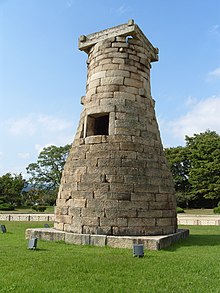Cheomseongdae
| Cheomseongdae | |
 |
|
| Korean name | |
|---|---|
| Hangul | 첨성대 |
| Hanja | 瞻星臺 |
| Revised Romanization | Cheomseongdae |
| McCune–Reischauer | Ch'ŏmsŏngdae |
Coordinates: 35°50′11″N 129°13′18.4″E / 35.83639°N 129.221778°E
Cheomseongdae is an astronomical observatory in Gyeongju, South Korea. Cheomseongdae means star-gazing tower in Korean. Cheomseongdae is the oldest surviving astronomical observatory in Asia, and possibly even the world. It was constructed in the 7th century in the kingdom of Silla, whose capital was Seorabeol, or present-day Gyeongju. Cheomseongdae was designated as the country's 31st national treasure on December 20, 1962.
According to Samguk Yusa, Cheomseongdae was constructed under the reign of Queen Seondeok (632-647) near the capital of the kingdom. Cheomseongdae means "star gazing platform". The tower is built out of 362 pieces of cut granite which some claim represent the 362 days of the lunar year. It has 27 circular layers of stones (some associate it with the fact that Queen Seondeok was considered to be the 27th ruler of Silla or the constellation of stars) surmounted by a square structure. 12 of the layers are below the window level and 12 are above. There are 12 large base stones set in a square, with three stones on each side. These sets of 12 may symbolize the months of the year.
The tower is 5.7 meters wide at the base and 9.4 meters tall, and filled with earth up to the level of the window. Its construction style parallels that used at the Bunhwangsa Temple in Gyeongju.
...
Wikipedia
